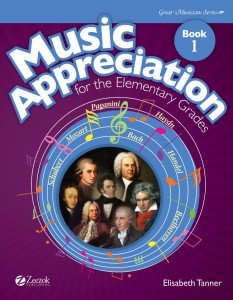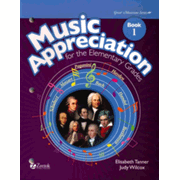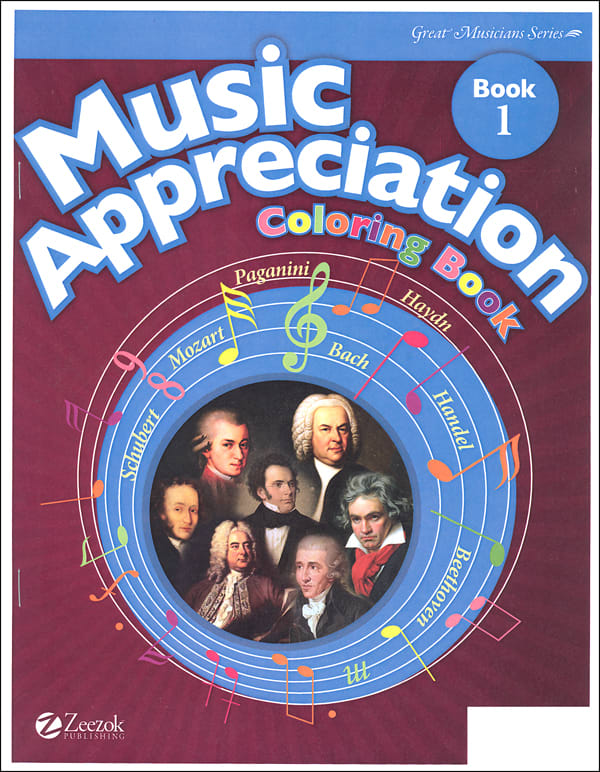Music Appreciation for the Elementary Grades is planned to be a series of two courses, although only Book 1 and the first course are available thus far. The course is perfect for homeschooling families since it is designed for kindergartners through sixth graders and it incorporates multi-sensory learning style methods to suit just about everyone. While students beyond sixth grade might also find it enjoyable, the course addresses the music appreciation and music theory standards from the National Association for Music Education for grades K through 6. (It does not try to meet performance standards.)
The course is set up in units with four weeks dedicated to each of seven composers: Sebastian Bach, George Frederic Handel, Franz Schubert, Ludwig Beethoven, Wolfgang Mozart, Nicolo Paganini, and Joseph Haydn. That’s a total of 28 weeks so it should take almost one school year to complete. Of course you can spread it out over two years if you like, especially if you choose to include other fine arts in your curriculum.
There are a number of components to the course, and which ones you purchase might depend upon both the ages of your children and their learning styles. The key components are the Student Activity Book, the Great Musician series of seven storybooks (one about each of the composers), a lapbook CD-ROM, and a set of five music discs (CDs). Optional items are a coloring book and a bingo game.
The Student Activity Book has brief information for the teacher at the beginning. Parents will need to refer to the Student Activity Book for the lesson plans. These are contained in a one-page “Weekly Lesson Outline” for each composer. These are bullet outlines of activities to be completed, each identified by an icon that makes it easy for a child to match up the activity in the list with the actual activity page in the book. Each Weekly Lesson Outline is followed by all of the pages for the four weeks of study. Lesson outlines also reference chapters in the Great Musician book to be read, lapbook activities, and music tracks on the audio CDs.
The activity book pages include comprehension questions for the Great Musician biography being read that month. The questions are followed by text that references the story to highlight character qualities exhibited by the composer and “Tidbits of Interest” that expand on the biographies with related information. Both of the two latter sections often add a Christian perspective. The course gently incorporates familiarity with church history, music in relation to worship, Christian character, and other elements of a Christian worldview. These three sections--questions, character qualities, and tidbits--are included for each week, but from there the activities branch out in many directions. The week’s activities might include map work, cut-and-paste activities. a geography oral report, copywork, a science experiment, a study of music and a particular culture, a crossword or word search puzzle, a vocabulary activity, making rhythm instruments and using them to make music, moving to music, “drawing to music,” (p. 71), learning about instruments of the orchestra or elements of music, cooking, or other activities too numerous to mention. Quizzes and answer keys are at the end of each unit.
The activity book is printed in full color. Each student will need to have his or her own copy since many pages are cut out or written upon. Activities vary in difficulty, but most can be adapted for use with younger and older students. A few activities such as essay writing might be restricted to older students. Some cut-and-paste activities might bore older students, so when an activity is transferring “text” information, you might consider having older students write in the information rather than cutting and pasting.
I especially appreciate how easy the Student Activity Book is to navigate. Students will work through the pages in order, following instructions to listen to the CDs or work on lapbook activities at the appropriate times.
The Great Musicians Series of biographical storybooks have been reprinted by Zeezok Publishing from a series that was first published in 1943. While they tell the story of each composer's life, they read like storybooks rather than information books; they make great read-aloud books even though most fourth and fifth graders can easily read them on their own. The delightful stories are accompanied by detailed black-and-white illustrations. Each book includes portions of the musical score for many pieces written by each composer. All of these are performed on the set of musical CDs.
The set of music CDs includes simple renditions of all of the musical compositions referenced in the stories as well as some fully-orchestrated pieces. The Student Activity Book has lists of all of the musical pieces on each CD as well as references to the page within each story where the piece is referenced. Those with some musical talent might choose to play the numerous, brief pieces of music that are included within each storybook.
The Lapbook CD-ROM integrates with the rest of the study providing reinforcement of key points as students create a lapbook for each composer. The CD includes a PDF with brief instructions, photos of completed lapbooks, and templates for most of the items to be created for each lapbook. Some illustrations will be cut from the Student Activity Book, but all lapbook items are provided with the course. Many of the lapbook templates include full-color illustrations that really should be printed on a color printer. All lapbooks follow the same basic layout which is shown on the “How to Create a Lapbook” page on the CD-ROM. You might want to print out this page and keep it handy since you will need to reference it until you get familiar with the layout scheme.
The optional Coloring Book illustrates 68 scenes from the storybooks. The line-drawn coloring pages have titles and captions so children know what is being depicted. These pages are drawn with quite a bit of detail, so they will likely appeal to older students as well as younger.
The optional Bingo Game has six, full-color game cards plus full-color “calling cards.” Squares show illustrations of various instruments, musical notes and symbols, and composers. It reinforces the basics of music theory and appreciation. Because bingo is a matching game rather than a test of knowledge, all ages can play.
Parents need to be involved to varying degrees depending upon the ages of their children. Younger children will likely need much of the material read aloud and discussed while older children might prefer to read and do at least some of the activities on their own. Parents need to make sure that lapbook pages are printed and ready as needed, but prep work is minimal for all but a very few of the activities (e.g., baking).
While music appreciation is the main goal of the program, students will certainly learn a great deal of history in the process, all while making connections to language, science, faith, and other topics. The wealth of activities is likely to make the course appealing to most students, and the design of the entire course makes it practical for the entire family to enjoy learning together.










